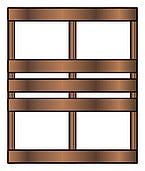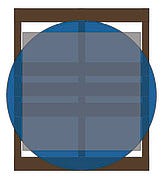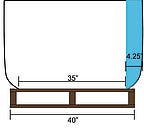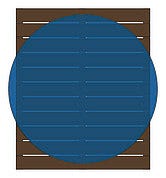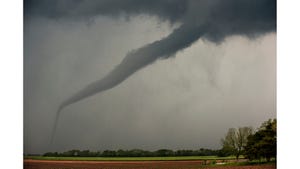The Importance of Choosing the Correct Pallet for Use with Bulk Bags
March 15, 2011
By Daniel R. Schnaars Jr., AmeriGlobe LLC
|
Figure 1: Bottom view of 40 in. x 48 in. pallet with top boards removed |
Pallets are used in most semi-bulk movements regardless of the package being used. In the case of boxes and small bags the pallets are chosen because they fit the needs of those packages. Unfortunately, bulk bags usually do not get that same consideration. Bulk bags traditionally are just placed on whatever pallets are readily available. In many cases the bulk bags suffer a reduction in performance and sometimes in safety.
To understand how important the pallet can be, let’s look at how the pallet works with both boxes and small bags.
Small Bags
Small, 25-kg bags are typically palletized using two bags laid vertically and three bags laid horizontally on each layer. By using this pattern, the bags cover the pallet without extending past the edges of the pallet. With the bag in this configuration the bags lock into place and shifting is minimized. The configuration of the pallet allows all three bottom slats to rest on stable product for the entire length of the slats. Since the whole slat is supported there is very little room to impart lean. Also, since the entire pallet foot print is utilized, any pallet stacked on top is fully supported.
|
Figure 2: Bottom view of 40 in. x 48 in. pallet showing its coverage of bottom bag in a stack |
Boxes
Boxes are rigid packages that have a defined shape and hold it. Pallets for boxes typically match the base size of the box. Since the box does not does deform, the size of the center of the box does not expand significantly over the pallet. This means that no point of the box overhangs the pallet so the area the pallet must support is static.
Boxes are meant to be stacked. The box derives its strength from its rigid sidewalls, so any stacking must be supported by the sidewalls. When one box is placed on another, the weight needs to be distributed evenly. The distribution of the boards on the bottom of the pallet allows the two outermost boards to rest on the side walls of the box. The length of the bottom boards allows them to rest on the boxes’ other two side walls. This arrangement offers a good distribution of weight.
Bulk Bags
Bulk bags offer several issues when choosing the appropriate pallet. Unlike the boxes, bulk bags derive their support from the product in them. Also, while bulk bags typically have square and rectangular bottom, the bags round out quickly just a few inches up from the bottom. Even though the top of the bag is sewn square, the hydraulic pressure of the product on the flexible package creates a cylindrical top. Finally, bulk bags are flexible packages so their shape changes as the product settles and shifts.
|
Figure 3: Side view of four-way pallet |
With all of those factors, how do you choose the right pallet? First, you have to decide if you are planning to stack your bags. If you are stacking then the bottom of the pallet is very important. As shown in Figure 1, the bottom of a typical pallet offers a very limited area of support. The center slats only support about 700 square inches, less than half of the surface area of the top of a bulk bag. To make matters worse, as the bulk bag rounds, only a small area reaches the front and rear slats of the pallet. Because the bags are flexible, it is possible for the bag to deform away from those small areas of support.
|
Figure 4: Side view of bag and pallet showing unsupported area of bag |
In Figure 2, the blue area shows the lack of support for the footprint after it rounds. The gray area shows the even greater lack of support if you believe the top footprint stays square. Either way, the best answer is to make sure your pallet has an extra slat in the front and back. This improves the support and allows your forklift operators a little latitude when stacking. Using a standard pallet, if the pallet is a little off center either forward or backward, the pallet will lean substantially in that direction. The lean is greatly exacerbated if you are using a four way pallet (Figure 3) since the runners are carved out and cannot support the bag. This creates a potentially dangerous situation.
The extra slats on the bottom of the pallet give another benefit as well. Typically when bulk bags are stacked using pallets the top sheet of the bottom bag tends to migrate into the opening of the pallet. This makes it more difficult to access the pallet. Frequently the tines will snag the top sheet and actually tear the fabric, leaving the product inside susceptible to contamination.
|
Figure 5: Top view of pallet |
Whether or not you are stacking your bags, the size of your pallet is an important consideration. Most bulk bags have base dimensions that are between 35 and 38 in. square. Not surprisingly, most companies use pallets that are 40 x 48 in., thinking that it adequately supports the bag. Unfortunately this is not the case. Bulk bags that are 35 in. square round to 44.5 in. While this is sometimes difficult to see when facing the bag, it is obvious from above. The base footprint will expand from a 35-in. square to 44-45 in. circle as the bag is moved and handled. This occurs because the bag is fundamentally a cylinder and gravity acts on the area of the bag that overhangs its small, square base as shown in Figure 4. As this happens the bag forms the circle shown in Figure 5. The part of the bag shown by the circle that is not on the pallet will continue to droop, imparting more and more lean in the bag. Again, this results in an unstable bag. To alleviate this issue, choose a pallet size that matches the diameter of your bag. For most bulk bags a 45 sq in. pallet is the best choice. This pallet works well in both overseas containers and trucks.
Conclusion
Regardless of which bulk bag design you use, your bag deserves and needs a pallet that meets its unique needs. Your boxes and 25-kg bags needs are addressed by their pallets; your bulk bags should be no different.
Daniel R. Schnaars Jr., is vice president of AmeriGlobe LLC (Lafayette, LA) and holds one of its numerous bag design patents. AmeriGlobe has been providing bulk bag solutions for more than 25 years. For more information, call 866-264-5623 or visit www.ameriglobe-fibc.com.
You May Also Like
